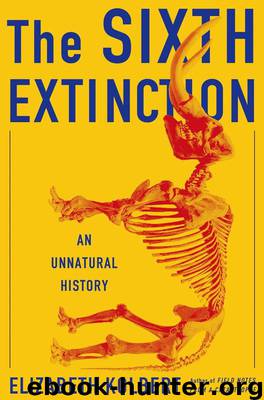The Sixth Extinction by Elizabeth Kolbert

Author:Elizabeth Kolbert [Elizabeth Kolbert]
Language: eng
Format: epub
Tags: Non-Fiction
ISBN: 9780805092998
Publisher: Henry Holt and Co.
Published: 2014-03-14T16:00:00+00:00
A typical example of the species-area relationship, showing the shape of the curve.
For the purposes of thinking about extinction, the species-area relationship is key. One (admittedly simplified) way of conceiving of what humans are doing to the world is that we are everywhere changing the value of A. Consider, for example, a grassland that once covered a thousand square miles. Let’s say the grassland was home to a hundred species of birds (or beetles or snakes). If half of the grassland were eliminated—converted into farmland or shopping malls—it should be possible to calculate, using the species-area relationship, the proportion of bird species (or beetles or snakes) that would be lost. Very roughly speaking, the answer is ten percent. (Here again, it’s important to remember that the relationship is not linear.) Since it takes a long time for the system to reach a new equilibrium, you wouldn’t expect the species to disappear right away, but you would expect them to be headed in that direction.
In 2004, a group of scientists decided to use the species-area relationship to generate a “first-pass” estimate of the extinction risk posed by global warming. First, the members of the team gathered data on the current ranges of more than a thousand plant and animal species. Then they correlated these ranges with present-day climate conditions. Finally, they imagined two extreme scenarios. In one, all of the species were assumed to be inert, much like the Ilex trees in Silman’s plots. As temperatures rose, they stayed put, and so, in most cases, the amount of climatically suitable area available to them shrank, in many instances down to zero. The projections based on this “no dispersal” scenario were bleak. If warming were held to a minimum, the team estimated that between 22 and 31 percent of the species would be “committed to extinction” by 2050. If warming were to reach what was at that point considered a likely maximum—a figure that now looks too low—by the middle of this century, between 38 and 52 percent of the species would be fated to disappear.
“Here’s another way to express the same thing,” Anthony Barnosky, a paleontologist at the University of California-Berkeley, wrote of the study results. “Look around you. Kill half of what you see. Or if you’re feeling generous, just kill about a quarter of what you see. That’s what we could be talking about.”
In the second, more optimistic scenario, species were imagined to be highly mobile. Under this scenario, as temperatures climbed, creatures were able to colonize any new areas that met the climate conditions they were adapted to. Still, many species ended up with nowhere to go. As the earth warmed, the conditions they were accustomed to simply disappeared. (The “disappearing climates” turned out to be largely in the tropics.) Other species saw their habitat shrink because to track the climate they had to move upslope, and the area at the top of a mountain is smaller than at the base.
Using the “universal dispersal” scenario, the team, led
Download
This site does not store any files on its server. We only index and link to content provided by other sites. Please contact the content providers to delete copyright contents if any and email us, we'll remove relevant links or contents immediately.
The Lonely City by Olivia Laing(4751)
Animal Frequency by Melissa Alvarez(4395)
All Creatures Great and Small by James Herriot(4233)
Walking by Henry David Thoreau(3895)
Exit West by Mohsin Hamid(3778)
Origin Story: A Big History of Everything by David Christian(3650)
COSMOS by Carl Sagan(3558)
How to Read Water: Clues and Patterns from Puddles to the Sea (Natural Navigation) by Tristan Gooley(3409)
Hedgerow by John Wright(3277)
The Inner Life of Animals by Peter Wohlleben(3261)
How to Read Nature by Tristan Gooley(3250)
How to Do Nothing by Jenny Odell(3235)
Project Animal Farm: An Accidental Journey into the Secret World of Farming and the Truth About Our Food by Sonia Faruqi(3178)
Origin Story by David Christian(3148)
Water by Ian Miller(3129)
A Forest Journey by John Perlin(3027)
The Plant Messiah by Carlos Magdalena(2883)
A Wilder Time by William E. Glassley(2818)
Forests: A Very Short Introduction by Jaboury Ghazoul(2790)
